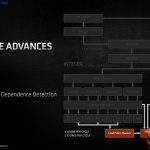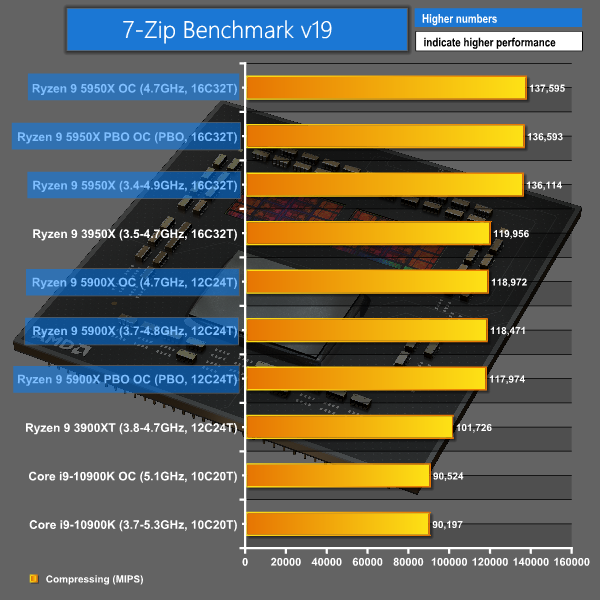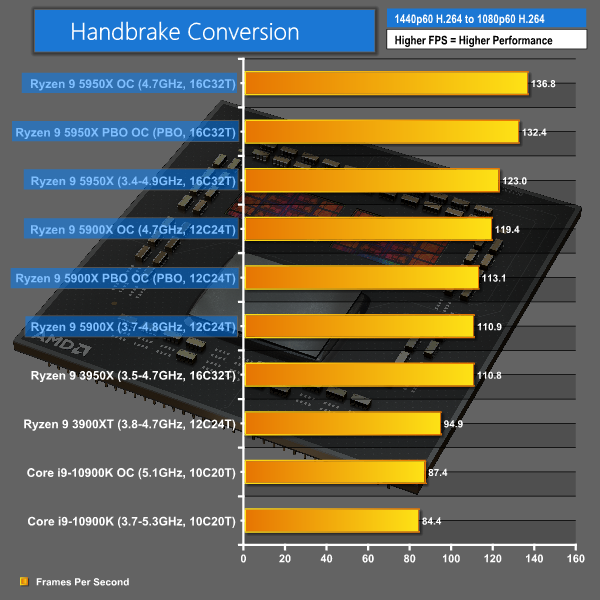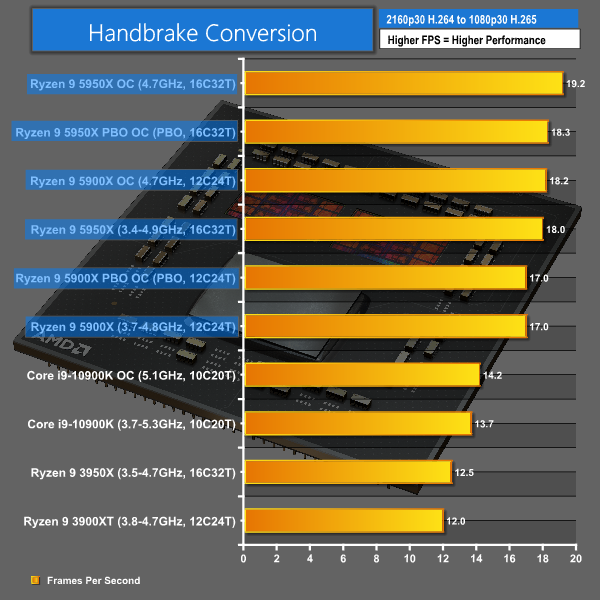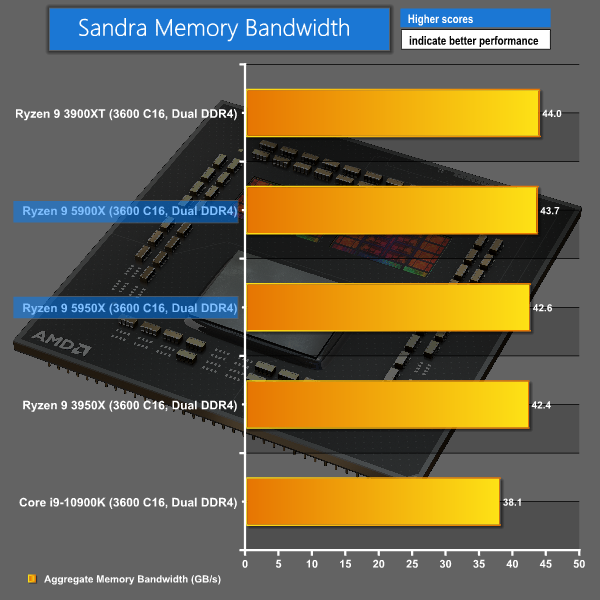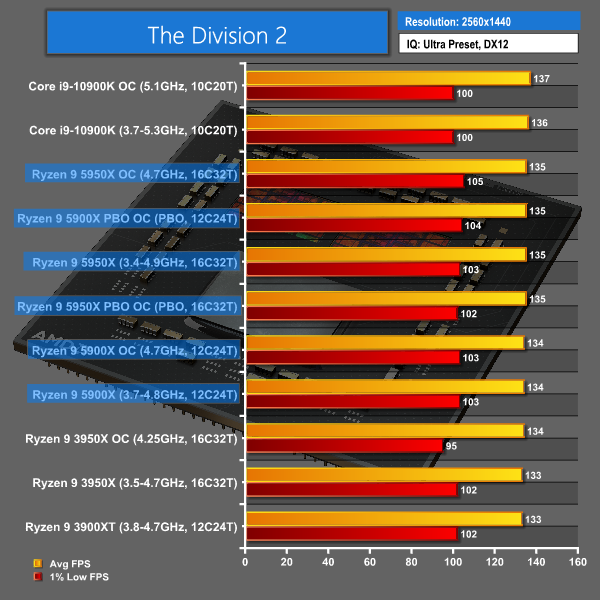
AMD’s new Zen 3 processors are finally upon us and they bring to the market a brand-new architecture that is touted as an impressive 19% IPC improvement over a single generational upgrade. We examine AMD's new 12-core Ryzen 9 5900X processor that is designed to replace the popular Ryzen 9 3900X from Zen 2. Can Zen 3 offer up the same balance of performance that we saw from Zen 2 whilst also closing the important gaming gap to Intel?
The AMD Ryzen 9 5900X is a 12-core, 24-thread processor that operates with a 3.7GHz base frequency and 4.8GHz maximum boost with a 105W TDP. MSRP is set at $549 and that converts into £510 in the UK. That’s a roughly £60-70 increase in price over the Zen 2 Ryzen 9 3900X/XT it replaces.
AMD's chosen process node is still TSMC 7nm but it is the tweaked design logic as applied with the frequency enhanced Ryzen 3000XT chips launched in July 2020. That should help reach and sustain higher boost clocks versus original Zen 2 Ryzen 3000X chips.
A pair of the new Zen 3 CCXs are deployed in the Ryzen 9 5900X to make up the 12-core total. This means that the cores have access to 64MB of L3 cache split across the two CCXs in CCD chiplet form, and you get the same 0.5MB of L2 cache per core as we saw with Zen 2.
In terms of other connectivity, AM4 platform support, physical CPU packaging, memory compatibility and everything else, it all stays that same as with Zen 2. That’s because AMD is using the same 12nm IO die used on Zen 2. The chiplet approach that Zen is built around allows AMD to simply plug-and-play the new Zen 3 chiplets with the ‘old’ Zen 2 IO die.
The discrete IO die and core chiplet approach really does continue to look like a stroke of genius from AMD.
With the same IO die used, we get the same generic connectivity. Most notably, you get 16+4+4 PCIe Gen 4 lanes, with four of those reserved for communication between the chipset and CPU. On-chip USB and SATA connectivity are the same, so check back to our previous content if you’ve forgotten what’s on offer.
And you also get the same support for dual-channel DDR4 memory with 3600MHz continuing to be the hassle-free sweet spot. The same memory rules as Zen 2 apply though – the memory controller and Infinity Fabric clock will run in the optimal 1:1 mode up to DDR4-3600MHz – a 1800MHz IF clock. Higher than 1800MHz Fabric clock will necessitate manual overclocking.
AMD does, however, highlight that 2000MHz Infinity Fabric clock is likely to be better achievable via overclocking, thus bringing the relevance of 4000MHz DIMMs into play.
In case it wasn’t obvious, you’ll need an AM4 motherboard for use with Ryzen 5000. X570 and B550 motherboard owners can update the BIOS and drop in the new chip underneath their same old cooler. Older 400-series motherboard compatibility is likely to come in future BIOS updates.
Notable competition for the £510 Ryzen 9 5900X comes from Intel’s £550 Core i9-10900K. Realistically, the tough competition comes from the now £60-80 cheaper 3900X/XT and Core i9-10850K which is basically a marginally slower 10900K.
Let's have a closer look at the Zen 3 architecture and the similarities and differences to Zen 2.
A key difference versus Zen 2 is that with Zen 3 we now get an 8-core CCX with ring architecture, rather than the 4-core CCX of Zen 2. This gives 32MB of L3 cache that is directly accessible by all eight cores on the Core Complex (CCX). Previously, the 4-core Zen 2 CCX needed a data transfer via Infinity Fabric to get to the neighbouring CCX when accessing more than 16MB of L3 cache on the CCD chiplet.
This doubling (depending on the specific chip, of course) in on-CCX cores and cache, in addition to many other under-the-hood adjustments made by AMD, have a benefit in improving latency performance. AMD also highlights how the larger, easier to access pool of L3 cache will help performance by reducing the reach out to memory operations, which can be particularly useful for gaming.
Another area where Zen 3 improves is clock speed. Now, the 16-core chip gets a maximum boost of 4.9GHz and the 12-core is rated for up to 4.8GHz. Of course, this will have the same previous caveats – it will be single- or very lightly-threaded workloads only that will see such clock speeds.
But the more recent AGESA revisions have proven successful from a boost clock standpoint, even though the max clock speed number is limited to light workloads.
Base frequencies show no notable increase in terms of rating, though. The 5950X is actually 100MHz slower base speed than the 3950X and the 5900X sees the same deficit versus the 3900XT. AMD’s use of the same TSMC 7nm process node, but with the design tweaks implemented for the Ryzen 3000XT processors, should push actual Precision Boost frequencies well above the rated base clock.
Operating clocks will probably be higher than the early Zen 2 Ryzen 3000X processors.
Other architectural improvements for Zen 3 include a larger L1 branch target buffer, improved branch prediction, reduced latency for select float and int operations, and higher load and store bandwidth.
The critical point for AMD’s architectural improvements with Zen 3 is the suggested IPC increase of 19%. That’s a sizable performance gain for a single generation improvement that still fits into the same platform.
Frequency, especially in all-core scenarios, was historically the area where people found issue with Ryzen 3000X/XT and Zen 2. Intel managed to push significantly higher clock speeds from its Skylake-based chips on the heavily refined 14nm process technology. That’s especially true when looking at all-core operating frequencies for Intel versus Zen 2 in power unlimited scenarios.
As such, we were hoping to see the new, optimised Ryzen 5000 chip operate at higher all-core frequencies when running at stock, PBO, and when overclocked.
Stock-Clocked Operating Frequencies:
We see the 5900X running at around 4.3-4.4GHz under an all-core load situation in the likes of Cinebench R20 and Blender. This an impressive boost clock figure for the 12-core chip directly out of the box as it is around 300MHz faster than even the 3900XT 12-core processor.
For the 5900X, we also saw clocks on a single core peaking at 4.95GHz and regularly operating above 4.85GHz and 4.9GHz. That is despite the maximum rated boost clock being 4.8GHz according to AMD's specifications.
Ryzen 9 5900X PBO Overclocking:
The 5900X in our testing ran with an all-core PBO operating clock of a little over 4.4GHz after extended periods of heavy load. This is fractionally lower than the PBO clocks we saw from the 5950X running PBO, thus implying that the 16-core chip is superior silicon (or is simply getting more juice to feed the cores).
These PBO numbers are reasonable, as the 5900X registers a solid improvement of around 50-100MHz versus its stock, Precision Boost behaviour.
Ryzen 9 5900X Manual Overclocking:
4.7GHz was the maximum stable all-core overclock we achieved with the Ryzen 9 5900X using a load delivery voltage of around 1.33V. This was tested on both the ASUS and Gigabyte motherboards with AIO and air cooling and worked very well throughout our testing.
With a good cooling solution, we think that slightly higher frequencies are likely to be achievable – we booted at 4750MHz all-core but could not maintain stability at our chosen voltage level.
For comments on Infinity Fabric overclocking and the limitations with current AGESA revision BIOSes, check out our Ryzen 9 5950X review article.
Overclocking Outcome:
We saw the same 4.7GHz all-core overclock with our Ryzen 9 5950X testing. This implies that the region of 4.7GHz with sensible voltage levels is an achievable point for Zen 2. The frequency benefits brought about from the enhanced design in the TSMC 7nm process node of the Ryzen 3000XT CPUs are present for Ryzen 5000 and look to be delivering solid clock speed behaviour.
PBO operation was good, thanks to the fact that maximum 1T boost clocks close to 5GHz are maintained. Based on our specific results, the choice of operating modes for the Ryzen 9 5900X will be around 4.4GHz multi-core and around 4.9GHz single core using PBO. Alternatively, a static 4.7GHz can be had through manual overclocking. Which behaviour better suits you will come down to individual use cases and preferences.
We will be outlining the AMD Ryzen 9 5900X CPU's performance while using X570 motherboards from ASUS and Gigabyte with the latest AGESA – 1.1.0.0 – BIOS version. A 32GB (2x16GB) kit of 3600MHz CL16 DDR4 memory serves our test system.
Today's comparison processors come in the form of:
- Comet Lake Core i9-10900K (10C20T).
- Matisse ‘Zen 2' Ryzen 9 3900XT (12C24T) and Ryzen 9 3950X (16C32T).
- Vermeer ‘Zen 3' Ryzen 9 5900X (12C24T) and Ryzen 9 5950X (16C32T).
Each processor is tested at its default out-of-the-box settings. For the Intel CPUs, unlimited turbo duration as set by the motherboard with XMP enabled is the operating mode. All-core load frequencies for the tested chips are as follows:
- Core i9-10900K = 4.9GHz.
- Ryzen 9 3900XT = around 4.05GHz.
- Ryzen 9 3950X = around 3.875GHz.
- Ryzen 9 5900X = around 4.3-4.4GHz.
- Ryzen 9 5950X = around 3.85-4.0GHz.
CPU Test System Components:
- Graphics Card: Gigabyte RTX 3080 Eagle OC.
- Memory: 32GB (2x16GB) Corsair Vengeance LPX 3600MHz 16-18-18-36 DDR4 @ 1.35V.
- CPU Cooler: Fractal Celsius+ S28 Prisma 280mm AIO at full pump and fan speed
- OS SSD: WD_Black SN750 NVMe SSD.
- Games SSD: Aorus 2TB PCIe Gen 4 M.2 SSD.
- Power Supply: Seasonic Prime TX-1000.
- Chassis: Lian Li T60 Open Air Test Bench.
- Operating System: Windows 10 Pro 64-bit.
- AM4 Motherboards: ASUS ROG Crosshair VIII Hero & Gigabyte X570 Aorus Master.
- Z490 Motherboard: MSI MEG Z490 ACE.
Tests:
Productivity-related:
- Cinebench R20 – All-core & single-core CPU benchmark (CPU)
- Blender 2.90 – All-core rendering of the Classroom benchmark (CPU)
- V-Ray Render Benchmark – All-core CPU render benchmark test (CPU)
- HandBrake H264 – Convert 1440p60 H264 video to 1080p60 H264 using the YouTube HQ 1080p60 preset (CPU)
- HandBrake H265 – Convert 4K30 100Mbps H264 video to 1080p30 40Mbps H265 using the H.265 MKV 1080p30 preset (CPU & Memory)
- 7-Zip – Built-in 7-Zip benchmark test (CPU & Memory)
- SiSoft Sandra – Memory bandwidth and Cache & Memory Latency Test (Memory)
- AIDA64 – Memory bandwidth & memory latency (Memory)
Gaming-related:
- F1 2020 – 1920 x 1080 & 2560 x 1440, Ultra High quality preset with TAA, DX12
- Grand Theft Auto V – 1920 x 1080 & 2560 x 1440, Maximum quality settings, no AA, DX11
- Metro Exodus – 1920 x 1080 & 2560 x 1440, Ultra quality preset, PhysX and Hairworks off, DX12
- Red Dead Redemption 2 – 1920 x 1080 & 2560 x 1440, High settings manually applied, DX12
- Shadow of the Tomb Raider – 1920 x 1080 & 2560 x 1440, Highest quality preset, no AA, DX12
- Tom Clancy's The Division 2 – 1920 x 1080 & 2560 x 1440, Ultra quality preset, no AA, DX12
Cinebench R20
Cinebench nT sees the Zen 3 chips setting a new tier of performance for mainstream platform options.
The 12-core 5900X blasts past the 10900K with a 35% performance lead. Versus the incumbent Zen 2 12-core, AMD’s new offering is an impressive 17% quicker. Manually overclocked to a lofty 4.7GHz the 5900X is able to offset a four-core deficit and leapfrog the stock 3950X 16-core chip’s performance.
For 1T operating, nothing can come close to the Zen 3 architecture in this test, and when the improvements to boost clock frequency and residency are coupled in, Zen 3’s performance lead is colossal. This result bodes well for performance in lightly threaded tasks, including games, going forward.
Blender Classroom Benchmark
Frequency improvements help to boost the 5900X to a 43 second render time benefit over the Zen 2 3900XT. A render time decrease of 13% when going from the old 12-core to the new 12-core highlights the improvements that AMD is bringing into play with Zen 3.
Versus Intel’s Core i9-10900K, the Ryzen 9 5900X is in a completely different performance league despite costing roughly the same.
V-Ray CPU Benchmark
23% is the lead for the 5900X versus the 3900XT and that is thanks to improved architecture and better all-core Precision Boost clocks. Overclocking the 12-core Zen 3 processor to 4.7GHz again allows it to marginally outperform the 16-core Zen 2 3950X at its stock clocks. Versus the Core i9-10900K, the 5900X is vastly superior.
7-Zip Compressing
7-Zip Decompressing
Architectural enhancements, most notably the larger slab of directly accessible L3 cache on each CCX, result in strong performance for Zen 3 in 7-Zip compression. The 12-core 5900X is within a hair of the performance of the Zen 2 AM4 flagship 3950X. That speaks volumes about the Zen 3 architectural improvements in this workload. In case you were interested, stock versus stock, the Ryzen 9 5900X is 31% faster than the Core i9-10900K. That’s a handy beat-down from AMD!
Decompression performance shows a similar trend, but it is more core count biased. The 5900X this time cannot trade blows with the higher core count Zen 2 3950X, but it does beat the incumbent 3900XT by an 18% margin. That performance victory for the 5900X over the Intel 10900K is a massive 53%.
Handbrake H264
Handbrake in our H264 test configuration struggles to leverage all cores on the 12- and 16-core parts. This brings architecture and boost clocks more into the picture and that is why we see very strong Ryzen 5000 performance numbers.
With the aforementioned architecture and clock comments in mind, we can see that the 12-core Ryzen 9 5900X roughly matches the 16-core Zen 2 3950X’s performance. Gains versus the 3900XT for the new Zen 3 12-core are 17%. And compared to Intel’s Core i9-10900K, the Ryzen 9 5900X is 31% slicker at stock.
Handbrake H265
Our Handbrake H265 test is more cache and clock speed sensitive as it often lingers at sub-60% core utilisation on a 16-core chip, for example. That is why we see Zen 2 struggle previously. Nevertheless, the architectural improvements for Zen 3 do a superb job at delivering new heights for our H265 test setup. This time, the performance leads versus Zen 2 and Coffee Lake are sizable for both the Zen 3 chips.
Sandra Memory Bandwidth
AIDA64 Memory Performance
Memory bandwidth numbers for Zen 3 are basically the same as with Zen 2. That comes as no surprise given the use of the same IO die and DDR4 subsystem. DDR4-3600MHz is still the sweet spot according to AMD, but future BIOS revisions may allow for a 2000MHz Fabric Clock that increases the relevance of 4GHz memory modules on AM4.
Memory latency performance, however, looks to have improved for Zen 3 versus Zen 2. This is likely to be another latency benefit that helps gaming performance. Intel’s Comet Lake Core i9-10900K is still slicker when it comes to raw memory latency numbers, though.
3DMark Time Spy
In 3DMark Time Spy performance, AMD does well with Zen 3 in the 16-core form but the 5900X cannot match the 10900K performance without a hefty overclock on the Zen 3 chip.
F1 2020
We use the DirectX 12 mode, TAA, and the Ultra High quality preset.
F1 2020 sees AMD making a positive start in gaming performance. At 1080p with an RTX 3080, the performance increases for Zen 3 over Zen 2 are evident, especially to high refresh rate gamers. Intel is still slightly faster at the top of the chart with the 4.9GHz+ 10900K. But AMD’s Zen 3 chips have reduced the Intel margin of victory convincingly.
At 1440P, we see the margins of performance difference narrow and all options are fine in this game.
Grand Theft Auto V
We use the DirectX 11 mode, anti-aliasing disabled, and the Maximum quality settings.
GTA V spells our first victory for AMD with Zen 3 and this is a noteworthy one. GTA V is an old, but still immensely popular and demanding DX11 title. AMD’s Zen 3 chips beating the Core i9-10900K in this test is notable given AMD’s historic struggles in the Intel-favouring GTA title.
Equally important is the sizable performance increase for Zen 3 versus Zen 2. This now makes the new Ryzen 5000 series chips excellent choice for high refresh rate gaming with GTA V, whereas previously, Intel was the superior option in that use case.
Increasing the graphics workload to 1440P sees the same trend hold true. Zen 3 is still a little faster than the Core i9-10900K and the performance improvement over Zen 2 is sizable.
Metro Exodus
We use the DirectX 12 mode, PhysX & Hairworks disabled, and the Ultra quality settings.
Metro Exodus flips the chart-topping position back to Intel’s Core i9-10900K. Here, Zen 3 shows another strong performance uplift versus Zen 2, but the Intel offering is slightly faster.
The key takeaway for Zen 3 is that it is now close enough to the 10900K’s performance levels to be considered a smart option for high refresh rate gaming, whereas that was not necessarily the case on Zen 2.
1440P shows the same performance trend, but the margins are constricted to the point where Zen 2, Zen 3, and Comet Lake all do well.
Red Dead Redemption 2
We run the game with image settings manually set to High and the DirectX 12 mode enabled.
Red Dead Redemption 2 using the DX12 API sees Intel maintain another top-spot performance result. In this modern title, Zen 3 is barely any quicker than Zen 2 using our chosen performance settings. High refresh rate gaming snobs, including myself, may be better impressed by the 10900K’s performance behaviour in this title.
At 1440P, Intel still maintains the performance lead with the 10900K and there is little difference in Zen 2 and Zen 3 FPS numbers.
Shadow of the Tomb Raider
We use the DirectX 12 mode, anti-aliasing disabled, and the Highest quality preset.
Shadow of the Tomb Raider flips AMD Zen 3 back into another chart-topping result, and this time by a notable margin. This game clearly likes the cache and latency enhancements made to Zen 3, as proven by the drastic performance uptick versus Zen 2.
At 1440p, the graphics workload is demanding enough to close the Zen 3 performance lead versus Intel. But AMD’s new Ryzen chips still prove a better option for high refresh rate gamers than Zen 2.
The Division 2
We run the game with quality set to Ultra, VSync disabled, and DX12 mode.
In the Division 2, Intel manages to switch the picture again with a chart-topping result from the Core i9-10900K. AMD’s Zen 3 options are marginally lower FPS than the Intel mainstream offering, but the performance difference is unlikely to disappoint any potential buyers. Versus Zen 2, Zen 3 shows another reasonable performance uplift in both average FPS and 1% low FPS values.
1440P increases the graphics workload to the point where all chips perform basically the same.
We leave the system to idle on the Windows 10 desktop before taking a power draw reading. For CPU load results, we read the power draw while producing five minutes' worth of loading in the Cinebench R20 nT rendering test.
The power consumption of our entire test system (at the wall) is shown in the chart. The same test parameters are used for temperature readings.
Power Consumption
Power draw readings are accurate to around +/-5W under heavy load due to instantaneous fluctuations in the value. We use a Titanium-rated Seasonic 1000W Prime PSU.
Power consumption still proves to be an area where AMD does very well with Zen 3.
The 5900X draws more power than the 5950X because the 12-core chip runs at higher clock speeds and therefore uses more of its 142W PPT allocation. Still, the power draw numbers at stock are impressively low and make the processor easy to handle from a motherboard VRM, PSU, and cooling perspective. That’s especially true when looking at the Core i9-10900K competitor that runs at around 50W higher load power in its turbo duration unlimited state.
Overclocking the 5900X via PBO or a manual 4.7GHz frequency again sees substantial increases in power draw numbers. This is again backed up with improvements to performance and it therefore presents itself as a good upgrade for enthusiasts who have higher spec partnering hardware that is capable of handling overclocks.
Performance per Watt
The 5900X does extremely well to get to a power efficiency number of anywhere near the Zen 2 3950X in light of the new chip’s core count deficit. The improvement versus the 12-core 3900XT is a sizable one for the stock 5900X. Zen 2 was excellent in terms of power efficiency and Zen 3 extends AMD’s lead over Intel’s 14nm 10900K in convincing fashion.
Temperatures
Temperature recordings were taken using the Fractal Celsius+ S28 Prisma 280mm AIO CPU cooler at full fan and pump speed. Ambient temperatures were around 22°C.
The 5900X runs hotter than the 5950X at stock thanks to its higher operating clock speed and power draw. We do, however, continue to see the operating temperature decrease for our Zen 3 samples versus the comparable Zen 2 chips.
This time, the PBO and 4.7GHz manual overclock numbers were very comfortable on a 280mm AIO cooler and were also handled with relative ease using a Noctua NH-D15S chromax.black air cooler.
From a temperature perspective, it looks like AMD’s Zen 3 will not push you to extremes. This is a very good point, especially with Intel upping their thermal game with the 10900K’s redesigned heatspreader. We’d be happy to use big AIO coolers with the 5900X and 5950X, but our testing also proved that air coolers will do a very good job
Performance per £ Value
Price increases have been noted with Ryzen 5000 versus Ryzen 3000 and 3000XT. However, the performance per £ metrics highlight that the price increases are in line with performance increases for the 12- and 16-core chips.
Couple in the fact that performance improvements outside of Cinebench workloads, such as in lightly threaded or gaming scenarios, are even higher and Ryzen 5000 actually looks to be very good from a value perspective. The new Zen 3 AMD Ryzen 9 5900X 12-core processor unlocks a new tier of productivity performance at a price point of just over £500. The architectural improvements of Zen 3, in the form of the new 8-core, 32MB CCX and under-the-hood latency enhancements have really delivered in a variety of workloads, including gaming.
Further performance uplift versus its predecessors and competition is delivered via the higher operating clocks for Ryzen 5000, despite still using the same TSMC 7nm process node, albeit with silicon design tweaks from AMD.
A reasonable gaming performance summary would be that AMD is no longer left lagging behind Intel in terms of gaming performance. In our testing, the Core i9-10900K at 4.9GHz+ remains a stellar option for high refresh rate gaming, but AMD has made significant strides with Zen 3 to close the performance gap.
Technically, the Intel chip still looks a little faster based on our testing, but with victories trading back and forth between the 10900K and Zen 3, I do not think it would be unfair to highlight both options as strong, market-leading gaming processors. The Zen 3 gaming performance improvement over Zen 2 is sizable and welcomed.
That uptick in gaming performance makes the 12-core 5900X a more tempting proposition to potential Core i9 buyers at this circa-£500 mark. The 5900X and its two-dozen threads will also appeal to users who need a balance between productivity might and gaming performance without shelling out for the more expensive Ryzen 9 5950X 16-core.
Overclocking has been improved by a substantial margin in both the manual OC and PBO forms. PBO looks to be a good balance for this generation, even if the increase in all-core boost clocks for the 5900X was in the order of 100MHz. The fact that single-threaded boost behaviour still performed better than AMD's 4.8GHz specification rating is another success of the Precision Boost algorithms.
The 12-core Ryzen 9 5900X is positioned in a reasonably challenging segment of the market at around £510. The Core i9-10900K is more expensive at around £550 and AMD convincingly offers a better all-round solution in the 5900X. That’s an easy and obvious win for AMD.
Where the challenge really presents itself is from the £430-450 Ryzen 9 3900X or 3900XT and the Core i9-10850K. The Core i9-10850K in particular is basically just a 10-core 10900K with slightly lower factory clocks and a much lower price tag, making it stiff competition.
The £60-70 price increase versus the Zen 2 12-core nets buyers an undeniably better processor than the 3900X/XT but that level of fee does represent the cost of a good 500GB NVMe SSD or stepping up to 32GB of RAM instead of 16GB. Overall, though, I feel that the 5900X is worth the price increase over its Zen 2 predecessors simply because the performance justifies it, the gaming calibre is far superior, and the clock speeds are notably enhanced.
Versus the Core i9-10850K, performance for which we will estimate from our 10900K numbers, the 5900X is again a better solution but it is around £70-80 more expensive. Here, however, that £70 increase in CPU pricing is less of a downside for AMD’s 5900X than it was versus the Zen 2 12-core part. That’s because Zen 3 has a strong AM4 platform cost and feature benefit over the Intel competition.
Some of that £70 saving on the Core i9 could quickly be gobbled up in higher Z490 motherboard pricing versus competent B550 alternatives. And of course, the £70 extra for the Ryzen chip is an obvious choice for users already with a compatible AM4 motherboard.
Put simply, the slightly more expensive 5900X + motherboard combination is worth its cost increase over the Core i9-10850K + motherboard competition. AMD’s chip is often just as fast in gaming, it’s more efficient, and it offers far superior productivity performance in multi-threaded, lightly-thread, and single-threaded workloads.
Zen 3 represents a significant addition to AMD’s product stack and really hammers home the point that AMD is still, without question, the dominant force in the desktop CPU market. Given the productivity and gaming performance on offer from the £510 Ryzen 9 5900X, the Core i9-10900K becomes even more irrelevant at its higher price point. And even the competitive Core i9-10850K will struggle to show its worth versus the new Zen 3 chip thanks to AMD's improved gaming performance and excellent all-round productivity capacity.
The AMD Ryzen 9 5900X MSRP is $549 USD and £509.99 in the UK. The Ryzen 9 5900X is currently available at Overclockers UK HERE.
Discuss on our Facebook page HERE.
Pros:
- Excellent performance in a variety of workloads – multi-threaded productivity, lightly-threaded tasks, and high refresh rate gaming.
- Impressive boost clock speeds up to 4.9GHz – often above its 4.8GHz specification rating.
- Good performance gains from manual overclocking to 4.7GHz.
- Excellent thermal performance with off-the-shelf CPU coolers.
- Strong power efficiency.
- Drop-in upgrade for current 500-series AM4 owners.
- Superior value versus Intel Core i9 competition.
Cons:
- Price increase versus the Core i9-10850K gives Intel's processor some room to contest.
- More expensive than its predecessor but justified with higher performance.
- Some may be irritated by the lack of CPU cooler versus the Ryzen 9 3900X predecessor.
KitGuru says: Strong in multi-threaded, lightly threaded, and single-threaded tasks ranging from rendering to gaming, the AMD Ryzen 9 5900X is a superb option at a little over £500 and represents excellent balance in AMD's Zen 3 product stack.
 KitGuru KitGuru.net – Tech News | Hardware News | Hardware Reviews | IOS | Mobile | Gaming | Graphics Cards
KitGuru KitGuru.net – Tech News | Hardware News | Hardware Reviews | IOS | Mobile | Gaming | Graphics Cards













